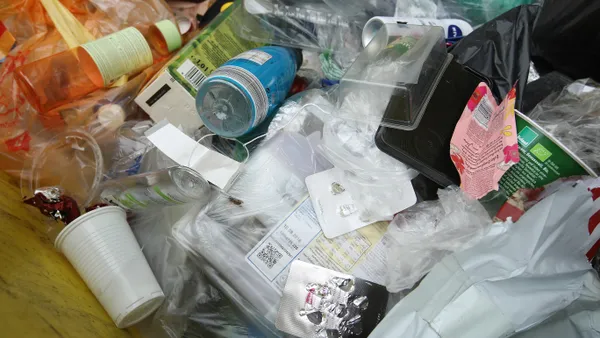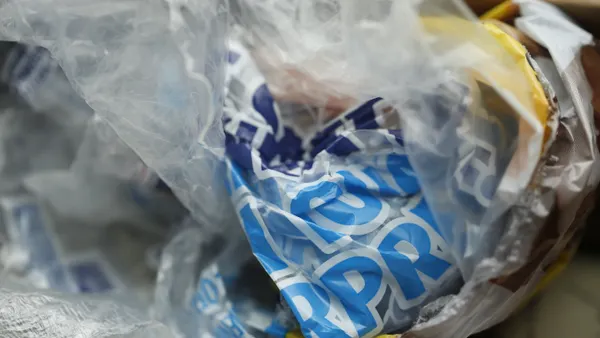UPDATE: May 6, 2020: The Materials Innovation Recycling Authority (MIRA) is reassessing a deal with the Sacyr Rooney Recovery Team (SRRT) over a $333 million plan to renovate its waste-to-energy facility.
The Connecticut Examiner reported that Tom Kirk, MIRA's president, said the outcome was "anticipated" and the coronavirus pandemic had thrown plans for an additional loop, given anticipated financial impacts to state and local budgets. MIRA will seek an alternative agreement ahead of a June 30, 2023 cut-off date. After that, the area's waste could be export to landfills in West Virginia, Ohio, or Pennsylvania.
Dive Brief:
- A $333 million plan to renovate a refuse-derived fuel facility operated by the Materials Innovation and Recycling Authority in the Hartford, Connecticut area is generating controversy, the Connecticut Examiner reported. The agreement between MIRA and the Sacyr Rooney Recovery Team would upgrade the 30-plus-year-old WTE plant, which serves 50 member towns, as well as a MRF.
- Under the 30-year redevelopment plan, disposal tip fees could increase to as much as $140 per ton or more. Current pricing is $83 per ton, after costs increased 15% last year to accommodate repairs at the struggling WTE facility. SSRT has also committed to exploring alternatives such as mechanical biological treatment and anaerobic digestion to help with the costs.
- MIRA did not respond to a request for comment, but the agency reportedly is considering using tax-exempt public bonds for financing and could seek qualification under expanded renewable energy credits. Member towns will first need to approve the plan. Project discussions have already dragged on for years and both sides need to reach a detailed financial agreement by October 2020.
Dive Insight:
Connecticut is entirely reliant on various forms of WTE for its in-state waste, but the state is struggling with pushback from environmental groups opposed to the practice, as well as from communities concerned about health and pollution implications. The MIRA plant accepts waste from many more affluent areas surrounding Hartford, which is home largely to low-income communities of color.
MIRA, a quasi-public agency, serves around 70 municipalities in Connecticut. Its WTE facility was converted from a coal power plant and has struggled with equipment failures and other issues. In November 2018, the plant suffered a double turbine failure, leaving around 20,000 tons of waste temporarily sitting indoors. That initial breakdown cost $15 million and hiked fees 15.3% for cities and towns.
The facility experienced another breakdown in June, shortly after returning to full service in March. While the second incident cost $1.3 million in repairs, it did not spur similar fee hikes on customers. However, MIRA did require private haulers to pay an increase of $15.19 per ton to cover the agency's expenses for shipping to out-of-state landfills.
MIRA's partnership with SRRT and subsequent redevelopment plan for the WTE plant is meant to address the site's ongoing problems, including new "state-of-the-art pollution control." But costs are likely to remain a hurdle, as is opposition from Hartford.
"Putting hundreds of millions of dollars into a failing facility at the wrong location is exactly the wrong outcome," said Hartford Mayor Luke Bronin in a statement to Waste Dive.
Mayor Bronin and the Hartford City Council have taken a strong stand against continued operation of the facility, despite receiving host payments. MIRA contends it could continue without their participation.
"Instead of spending hundreds of millions of dollars to tape together an obsolete facility in the wrong location, we should be stepping back, looking at the most environmentally sound, fiscally responsible solutions and then asking ourselves, ‘What’s the best location for that facility?’” said Bronin.
Environmental advocates are also critical of the plan. "I find it hard to imagine that towns are going to look kindly on being asked to approve something that's going to significantly increase the tipping fees," said Kevin Budris, an attorney with the Conservation Law Fund (CLF).
Budris, whose organization opposes any form of WTE, told Waste Dive that the high costs "highlight just how expensive incineration is" at a time when many facilities are aging and closing.
If the agreement between MIRA and SRRT falls through, Connecticut will likely be forced to reevaluate its options. While some incineration opponents say that could lead officials to boost composting and recycling, along with other waste diversion efforts, it is also possible that the state's waste could be hauled to out-of-state landfills or incinerators, an emissions-heavy process.
Julie Cammarata, principal at Cammarata Government Affairs and an active lobbyist on state waste issues, told Waste Dive in December 2019 that WTE could have other paths forward in Connecticut. "What we need to do is have smaller capacity," she said, suggesting that smaller plants around the state could be more effective than existing large facilities that are costly and aging.
Those sites, she proposed, could work in conjunction with other stakeholders by prioritizing waste diversion and boosting composting, anaerobic digestion and recycling markets at the same time – while still leaving space for WTE expansion. Companies like Wheelabrator and Covanta could be involved in those conversations, Cammarata said, in an effort that might bolster economic development at a time when Connecticut is struggling to address its waste disposal needs.
"Sometimes that's when the real genius comes out, when we're under the wire," she added.









